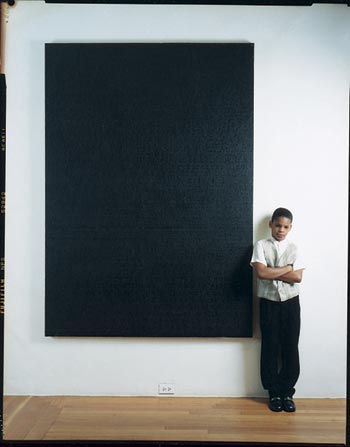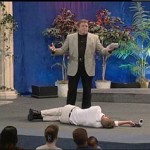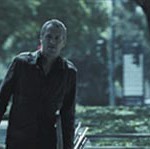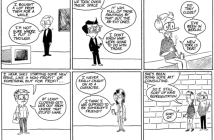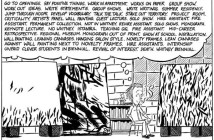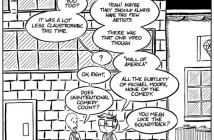Christian Jankowski: Everything Fell Together, consists of 12 works, all of which entail a greater or lesser degree of collaboration between Jankowski and individuals or institutions external to the art world. In engaging with these disparate constituents, creating his work through his interactions with them, Jankowski is absorbed into both the visual and more explicitly meaning oriented structures of popular cultural forms.
In all of these works, we see Jankowski collaborate with strangers in the creation of the work. In a number of instances, Jankowski’s work is primarily that of organizing or editing the actions of his collaborators – whether as a director of short films and videos as in This I Played Tomorrow, or by taking actions near to his collaborators by which he subtly alters their actions, as in Talk Athens. In many instances, the interest stems from the unexpected or naively charming actions of his collaborators, especially in The Matrix Effect, in which children, acting the parts of art world luminaries, say the darnedest things.
The pursuit of art in the form of novel effect is often flatly (or breathlessly) stated in these works. As Pastor Peter Spencer says in The Holy Artwork, “You’ve never seen this piece of holy art . . . that’s what makes it art.” Jankowski appears to “make it new” quite sincerely. Unless, of course, he is gently mocking (everything appears gentle here) our desire, as viewers of contemporary art, and, perhaps more importantly, a purported lay public’s desire, as less initiated viewers, to see the new. The joke would appear to be on us, however, as Jankowski locates this new thing squarely in the context of the already known – the talk show, the sermon, the PBS documentary, the magic trick, the American blockbuster or the Korean karaoke video.
In Talk Athens, the work of art being created by the discussion of the creation of a work of art is in fact the document of that discussion. It’s a kind of international stoner art, and demands quite a bit of Jankowski’s collaborators. Do they have interesting things to say about the artwork being created? More pointedly, does the structure of the TV talk show enable a discussion of the artwork that is of interest as a discussion? Or is the content of the work different from the content of the conversation, even as it is perturbed by Jankowski’s silent and seemingly interested presence on the set of the show, to which the participants refer often, with varying degrees of comfort. If we are to understand the work as simultaneously consisting of Jankowski’s intervention and the record of the discussion it generates, we must ask whether his presence is really all that interesting, especially insofar as it enters into the cultural feedback loop of the talk show as much as that of any other guest. In organizing this work, as well as The Holy Artwork and Telemistica, as constituted almost solely by the discourse it generates, and specifically in the discursive structures of various media, Jankowski begs the question of where we locate the meaning and/or value of the work at hand, and by extension, of how we ascertain value in contemporary art.
This does not necessarily mean that the work is engaging as such. Especially in those instances in which Jankowski makes use of (collaborates sometimes seems too strong a word) people less than conversant in contemporary art, the effect of the work arises from the ironic distance between what we know as we view the final document and what they know (or more accurately, what we imagine them to know) as they take part in the creation of the artwork. Whether our laughter is empathetic – as with the charming malapropisms of the children in The Matrix Effect – or not, as with the yoking of contemporary art to the Judeo-Christian God in The Holy Artwork, the persistence of this effect in so many of Jankowski’s works , makes revisiting them a case of diminishing returns.
While The Holy Artwork maintains interest thanks to the rhetorical efforts of Peter Spencer, works such as Talk Athens and Telemistica are ultimately undone by the sheer banality of their contexts. Inasmuch as these three works share fundamentally similar structures, the latter two works seem somewhat redundant. Indeed, it is only thanks to the inadvertent comedy in this context of Spencer’s endlessly complicated efforts to frame contemporary art in terms of God that the work remains interesting. However, we cannot help but wonder if the targets of our laughter are, like the groceries that Jankowski shoots with a bow and arrow before purchasing in The Hunt, a little too easy to hit.
In The Day We Met, Jankowski becomes a character in a quartet of Korean karaoke videos. One doesn’t so much need a contemporary artist as a night out to notice and take pleasure in how karaoke videos are formulaic and highly stylized. If Jankowski means to mine the formulaic in order to arrive at the emotional content it has schematized into parody, the effect is somewhat lost due to his performance. We are in on the joke, but it seems more desirable to be unaware a joke is being made.
It is only in 16mm Mystery that Jankowski’s use of known structures of meaning becomes especially interesting, and this has more to do with what we do not see – the 16mm film Jankowski projects – than with what we do see. Given the parameters of the work, it is all but inevitable that some catastrophe should befall the building. Hollywood special effects have historically been oriented towards the creation of specific kinds of spectacle, and from the moment we see the building, it is a safe bet that it is coming down, one way or the other. In this work, Jankowski renders the space between the ostensible spectacle of the building’s collapse as understood through Hollywood film and the ultimate banality of its effect more starkly – the special effects are anything but special.
What is of interest in this work is the proposition made of a causal relationship between the film he projects (which we don’t see) and the pictured (but not actually happening) events of the film which we do see. As in those works in which Jankowski inserts himself into public discourses, even silently, art’s function is that of a reality-distorting field. Except that the effect of art in 16mm Mystery is just that, a manufactured effect, less real than Jankowski’s act of setting up and starting the projector (which actually happened), although they are finally flattened into the same presence on 35mm film.
In film, the MacGuffin is a plot device that exists solely to motivate action on the part of the characters, to activate their desires. It need not be explained to the audience as long as its importance to the characters is believed. In 16mm Mystery, the unseen movie is a sort of MacGuffin. Yet it commands, by its centrality to the narrative – the mystery is not what happened to the MacGuffin, but of what it is - greater interest than the events which surround it. It offers up the oft-mentioned “new” in Jankowski’s work, in the form of the unknowable rather than the intervention in the already known. I would really like to see that movie, yet know there may be nothing to see.
Does this make our desire for the new, the transformative, as they are so often invoked in Jankowski’s work, a case of false hope or naïve expectation? In The Matrix Effect, children voice the laudatory comments of artists and curators regarding the Wadsworth Athenaeum’s contemporary art program. As the child playing Jim Elliot states, “It is rewarding to think you have done something which has benefited many people.” It certainly is rewarding to think so, but Jankowski’s work often suffers from the same short shelf life of the media with which he engages.
- Christian Jankowski, The Matrix Effect,C-prints, 2000.
- Christian Jankowski, The Holy Artwork, video, 2001.
- Christian Jankowski, 16mm Mystery, 35 mm film, 2004.
Links:
MIT List Visual Arts Center
"Christian Jankowski: Everything Fell Together" is on view from October 14 - December 31, 2005 at the MIT List Visual Arts Center.
All images are courtesy of the artist and MIT List Visual Arts Center.

